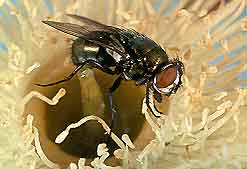
|
CALLIPHORIDAE Blowflies or Bluebottles |
|
| ||||||||||||
|
This family consists of small to medium sized flies commonly known as blowflies or bluebottles. Many species are metallic blue or green or a mixture of brown and black. Some are beneficial to humans as they help speed up decomposition of dead animals, while others are economic pests. The larvae of most calliphorids live in carrion or dung, although some species are known to be parasitic.
Lucilia cuprina, commonly known as the sheep blowfly is an introduced pest which causes blowfly strike in sheep. Sheep blowfly can be found anywhere in Australia where suitable sheep hosts occur. Female sheep blowflies seek out a suitable host by smell, with most flystrike occurring during the warmer months of the year. Carcasses or sheep with lumpy wool or damp wool, fleecerot, skin lesions or dags are particularly attractive to these blowflies. Their maggots feed on irritated skin under the wool and eventually attack the living tissue causing severe lesions and sometimes death. Sheep blowflies are only able to produce eggs after they have had a protein meal which they most likely get from animal dung or a carcass. The flies then mate and the females begin their search for a suitable host. Eggs are laid in batches to prevent drying out and the batches may be made up of the eggs from more than one female. The eggs hatch after about half a day and the tiny white maggots begin to feed. The maggots develop through several moults, becoming larger and more voracious until they are fully mature. At this stage they drop to the ground and burrow a short distance into the soil. Here their outer skin forms a hardened cocoon and they pupate into an adult fly. Sheep blowflies live for several weeks producing up to 3 generations over the spring and summer months. If the weather becomes too cold the pupa will overwinter in the ground and emerge in the following spring. For more blowfly species visit the Australian Insect Common Names |
